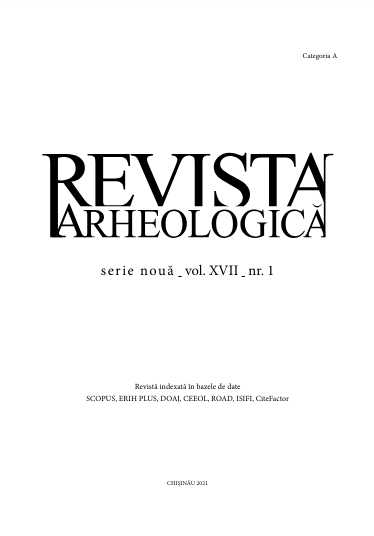Могильник ногайской культуры у с. Казаклия
The nogai culture necropolis in the Cazaclia village
Author(s): Sergei Agul’nikov, Viltalii ZheleznyiSubject(s): Archaeology, Museology & Heritage Studies, Middle Ages, Cultural Anthropology / Ethnology, Culture and social structure
Published by: Institutul Patrimoniului Cultural al Academiei de Științe a Moldovei
Keywords: Bugeac; Cazaclia; necropolis; migratory;
Summary/Abstract: The medieval flat necropolis near the village of Cazaclia (Ceadîr-Lunga district, ATU Gagauzia) was discovered in 2005. The site is located on the northeastern edge of the Cazaclia village, near of the current cemetery of the village. The profile of the clay quarry contains the contours of the pits of the funerary structures. A number of pits are lined and covered with stone, there are also simple burial chambers. The site needed an archaeological research because it was disturbed by clay mining and atmospheric phenomena. It was researched an area of 372 sq.m. First, the graves in the quarry wall were searched, on the verge of collapsing. Following the archeological excavations, there were identified and studied 40 tombs of the medieval Nogai nomads. The graves of adults and children are rectangular burial pits with complex structures with lining, steps and curbs. Remains of wooden coffins where found in some graves. The buried are facing the Sunset, and the facial part of the skull is facing southeast, in the direction of Mecca and Medina – this orientation was inherent in the Islamized Turkish population in the Black Sea steppe region. The condition of the bones of adults is satisfactory. Children’s skeletons are poorly preserved, which is caused by a lack of calcium in the diet of the Nogaic population. In some tombs, remains of wooden structures can be traced – covering planks and even wooden coffins. In the flat necropolis the tombs of the walnut trees form certain rows from east to west. The tombs are practically without inventory, excepting a bronze ring in the grave no. 2 of one of the children. However, the elements of the funeral rite and the anthropological material of the discovered bone remains will make it possible to further study the problem of walnuts in the southern regions of the Republic of Moldova. It should be mentioned that this is the first detailed research aimed at studying the population of walnuts that lived in Bugeac in the sixteenth and eighteenth centuries, conducted after the 90s of the XXth century.
Journal: Revista Arheologică
- Issue Year: XVII/2021
- Issue No: 1
- Page Range: 81-98
- Page Count: 18
- Language: Russian

